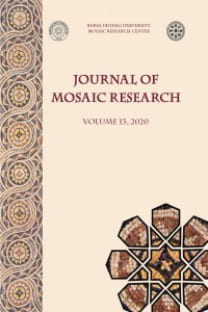Kuzey Suriye'de Bulunan Mezar Mozaiği
2007 yılında, Suriye Eski Eserler ve Müzeler Müdürlüğü tarafından, Kuzey Suriye’deki Frykia köyündeki bir mezar odasında gerçekleştirilen kazıda bir mozaik bulunmuştur. Bu mozaik üzerinde, iki sütun arasında, bir meyve ağacının yanında durur şekilde birbirine doğru bakan bir çift hayvanın betimlenmiş olduğu ilginç bir sahne yer almaktadır. Bu dekor çalışması, bu eserin İ.S. 6. yüzyıla tarihlendirilebileceğini düşündürmektedir. Ayrıca bu ikonografik tema hayvanlar alemindeki barışın üzerinde duran Isaiah 11:6’dan esinlenilmiş olup 6. yüzyıl Suriye mozaik sanatı geleneği ile yorumlanarak betimlenmiştir. Bir gömü odasına ait olan mozaik üzerindeki bu tür bir betim Hıristiyanlık’ın ölümden sonraki yaşamla ilgili yorumlarını yansıtması bakımından oldukça önemlidir.
Funerary Mosaic Found in Northern Syria
A mosaic was discovered in 2007, in a funerary chamber at Frykia village in northern Syria, by the excavation service of the Directorate of Antiquities and Museums of Syria. This mosaic presents an interesting scene consisting of two columns with a pair of animals facing each other next to a fruit tree. The study of the decor suggests that this mosaic belongs to the 6th century B.C. and that the iconographic theme is inspired by Isaiah 11:6 concerning the animal kingdom of peace and is rendered according to the Syrian tradition of mosaic art from the 6th century. The representation of this topic in a mosaic belonging to a funerary chamber has a significance, regarding the Christian interpretation of life after dead.
___
- Abdallah 2009 K. Abdallah, Les mosaïques du musée de Maaret An-Nouman (Syrie du Nord), Etude décorative, iconographique, épigraphique et symbolique, Thèse de doctorant non publié, L’Université de Paris-1, Paris.
- Abdallah 2014 K. Abdallah, “La représentation du paradis dans les mosaïques Syriennes à l’époque Byzantine”, dansParadeisos: Genése et métamorphose de la motion de paradis dans l’Antiquité, édité par Eric Morvillez, Paris, 297-314.
- Balty 1977 J. Balty, Mosaïques antiques de Syrie, Bruxelles.
- Bible The Holy Bible, English standard version, Crossway Bibles, Wheaton, 2001.
- Campbell 1995 S. D. Campbell, “The Peaceful Kingdom: a liturgical interpretation”, R. Ling (ed.), Vth International Colloquium on Ancient Mosaics, JRA Supp. Series 9.2, 125-134.
- DGAM 2007 Directorate of Antiquities and Musuems in Syria: A preliminary report of the discovery of a mosaic in Frykia village, in Arabic.
- Donceel-Voûte 1988 P. Donceel-Voûte, Les pavements des églises byzantines de Syrie et du Liban, décor, archéologie et liturgie, Louvain-la-neuve.
- Duval 1976 N. Duval, Les mosaïques funéraires dans l’art paléochrétien, Longo, Ravenne.
- Gough 1974 M. Gough, “The Peaceful Kingdom” An Early Christian Mosaic Pavement in Cilicia Campestris”, Mansel’e Armağan / Mélanges Mansel I, 411-419.
- Isaiah Théodoret de Cyr, “commentaire sur Isaïe” Tom II (section 4-13), traduit par Jean. Noël Guinot 1982, Paris.
- Levi 1947 D. Levi, Antioch Mosaic Pavements I-II, Wisconsin, Princeton.
- Metzger 2003 M. Metzger, “La résurrection dans les Constitutions apostoliques”, dans la résurrection chez les Pères, Cahiers de Biblia Patristica 7, Strasbourg UMB 2003, 229-245.
- Piccirillo 1989 M. Piccirillo, Mosaïque Byzatine de Jordanie, Lyon.
- Piccirillo 1993 M. Piccirillo, The mosaics of Jordan, Amman.
- Russell 1987 J. Ruseell, The Mosaic Donor Inscriptions of Anemurium, Vienna, Verlag der Oesterreichischen Akademie der Wissenschaften.
- Şener 2011 Y. S. Şener, “Mozaiklerin Korunmasında Temel Kriterler”, M. Şahin (ed.), XIth International Colloquium on Ancient Mosaics (October 16th-20th, 2009, Bursa Turkey), 873-882.
- Zebawi 1998 M. Zebawi, “Fidélité et créativité”, dans le l’art paléochrétien : des origines à Byzance, édité par M.A. Crippa et M. Zebawi, Milan, 217-308.
- ISSN: 1309-047X
- Başlangıç: 2008
- Yayıncı: Ululdağ Üniversitesi, Mozaik Araştırlmaları Merkezi
Sayıdaki Diğer Makaleler
Myrleia’dan Yeni Keşfedilen Bir Mozaik
Opus Signinum, Terrazzo, Harç ve Beton Kaplama: Sorunsal Durum
Bir Geometrik Mozaik Dekorunun Doğru Bir Şekilde Belirlenmesi Gereği Üzerine Bir Vaka Çalışması
Nissma BOUZOUBAA, Abdelilah DEKAYİR
Terrazzo, Harç ve Beton Kaplama: Sorunsal Durum
Kuzey Suriye'de Bulunan Mezar Mozaiği
Metropolis Mask Mozaiğinin Geometrik Çözümlemesi
Apollonia’daki (Arnavutluk) Athena Domus’u: Yeniden Değerlendirme
